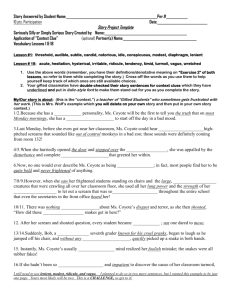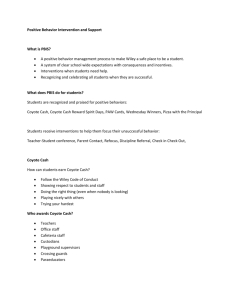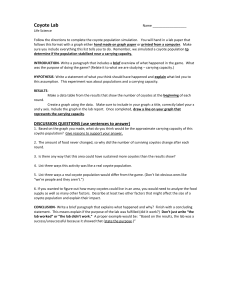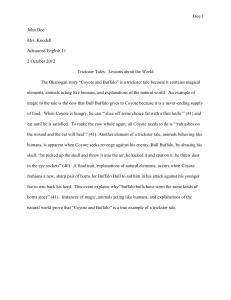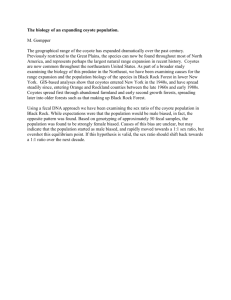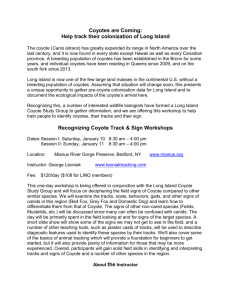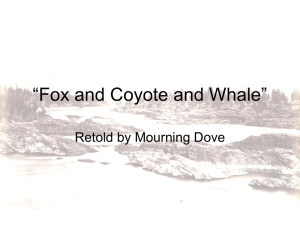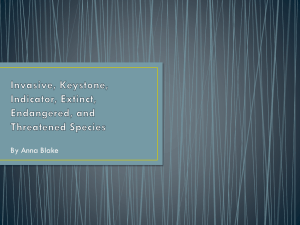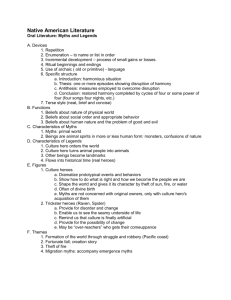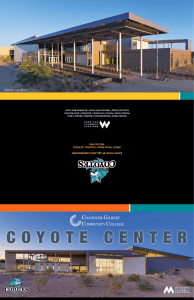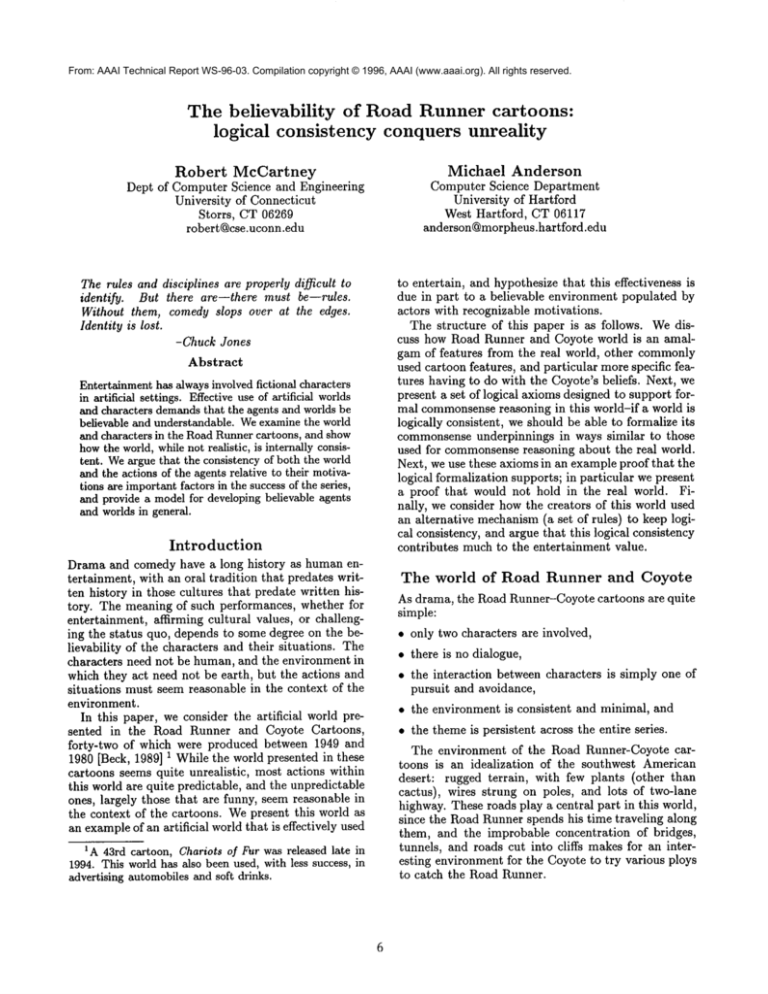
From: AAAI Technical Report WS-96-03. Compilation copyright © 1996, AAAI (www.aaai.org). All rights reserved.
The believability
of Road Runner cartoons:
logical
consistency
conquers unreality
Robert McCartney
Michael Anderson
Dept of Computer Science and Engineering
University of Connecticut
Storrs, CT 06269
robert@cse.uconn.edu
Computer Science Department
University of Hartford
West Hartford, CT 06117
anderson@morpheus.hartford .edu
The rules and disciplines are properly difficult to
identify.
But there are--there must be--rules.
Without them, comedy slops over at the edges.
Identity is lost.
-Chuck Jones
Abstract
Entertainmenthas alwaysinvolved fictional characters
in artificial settings. Effective use of artificial worlds
and characters demandsthat the agents and worlds be
believable and understandable. Weexaminethe world
and characters in the RoadRunnercartoons, and show
howthe world, whilenot realistic, is internally consistent. Weargue that the consistency of both the world
andthe actions of the agents relative to their motivations are importantfactors in the success of the series,
and provide a modelfor developing believable agents
andworlds in general.
Introduction
Drama and comedy have a long history as human entertainment, with an oral tradition that predates written history in those cultures that predate written history. The meaning of such performances, whether for
entertainment, affirming cultural values, or challenging the status quo, depends to some degree on the believability of the characters and their situations. The
characters need not be human, and the environment in
which they act need not be earth, but the actions and
situations must seem reasonable in the context of the
environment.
In this paper, we consider the artificial world presented in the Road Runner and Coyote Cartoons,
forty-two of which were produced between 1949 and
1980 [Beck, 1989] 1 While the world presented in these
cartoons seems quite unrealistic, most actions within
this world are quite predictable, and the unpredictable
ones, largely those that are funny, seem reasonable in
the context of the cartoons. Wepresent this world as
an exampleof an artificial world that is effectively used
1A 43rd cartoon, Chariots of Fur was released late in
1994. This world has also been used, with less success, in
advertising automobilesand soft drinks.
to entertain, and hypothesize that this effectiveness is
due in part to a believable environment populated by
actors with recognizable motivations.
The structure of this paper is as follows. Wediscuss how Road Runner and Coyote world is an amalgam of features from the real world, other commonly
used cartoon features, and particular more specific features having to do with the Coyote’s beliefs. Next, we
present a set of logical axioms designed to support formal commonsensereasoning in this world-if a world is
logically consistent, we should be able to formalize its
commonsense underpinnings in ways similar to those
used for commonsensereasoning about the real world.
Next, we use these axioms in an example proof that the
logical formalization supports; in particular we present
a proof that would not hold in the real world. Finally, we consider howthe creators of this world used
an alternative mechanism(a set of rules) to keep logical consistency, and argue that this logical consistency
contributes muchto the entertainment value.
The world of Road Runner and Coyote
As drama, the Road Runner-Coyote cartoons are quite
simple:
¯ only two characters are involved,
¯ there is no dialogue,
¯ the interaction between characters is simply one of
pursuit and avoidance,
¯ the environment is consistent
and minimal, and
¯ the theme is persistent across the entire series.
The environment of the Road Runner-Coyote cartoons is an idealization
of the southwest American
desert: rugged terrain, with few plants (other than
cactus), wires strung on poles, and lots of two-lane
highway. These roads play a central part in this world,
since the Road Runner spends his time traveling along
them, and the improbable concentration of bridges,
tunnels, and roads cut into cliffs makes for an interesting environment for the Coyote to try various ploys
to catch the Road Runner.
The theme: the Coyote (Eatibus Almost Anythingus) is hungry and sees the Road Runner (Tastyus Supersonicus) as his only chance for a decent meal but
the Road Runner is too fast for the Coyote simply to
chase and catch. His only chance is somehowto trap
the RoadRunnerand, for the duration of the series, his
planning and scheming bring him pain, suffering, and
indignity ... but no Road Runner! The Road Runner
spends his days, appropriately, merrily running along
the road and has little interest in the Coyote and his
doings. His sole contribution to the affair is a few wellplaced "beep-beeps" that startle the Coyote into compromising positions.
While many things in the environment have realworld analogs, other features are typical of cartoons-a commonclich~ is a character whowalks off a cliff or
steps out of a windowto not fall toward the ground
until he notices that he is not supported by anything,
or a character whodoes not feel pain when set on fire
until he sees that he is burning. The abstraction here
seems to be that physics is affected by the knowledge
or belief of the involved characters. This notion is very
commonin these cartoons, where much of what happens seems to depend on the beliefs and intentions of
the Coyote.
If this world is believable and understandable, it
should be describable by some set of axioms, as has
been done for commonsense reasoning about things
in the world. The differences between this world and
the real world complicate the job of axiomatizing this
world, but such an axiomatzation provides evidence
that the world is in general logically consistent, and
the efforts could lead to a greater understanding of the
sorts of differences that an artificial world might exhibit without becoming too alien to be understood.
Road
Runner-Coyote
according
to
formal logic
The basis for the axiomatization of the Road Runner
- Coyote Microworld is sorted modal temporal logic
[Davis90]. Included in the axiomatization are a number of necessary modal belief and knowledge axioms
and axioms required for reasoning about the physical
objects used by the Coyote in his never-ending quest
of Road Runner Tartare. The axiomatization of this
microworld is to the end of proving that, no matter
what situation they find themselves in, the Coyote will
never catch the Road Runner.
The approach taken by the current work is to axiomatize a subset of situations that are portrayed in the
series of cartoons such that an interesting set of axioms can be developed. Further, this set of situations
has been chosen such that inconsistent and anomalous
situations are avoided, allowing for a simpler, consistent set of axioms. This is a necessary tack because
not all behavior in this microworldis logically consistent. For example, at least once the Coyote sets up a
trap that requires the Road Runner to stop and read
RRC.17. occurs(/,fall(A))
knows(A, -~3y
true_in(start(1),support(Y, A)),start(I))
(Toonville Clichd I: Agent A will only fall if A knows
that nothing supports A.)
RRC.18. occurs(/,burn(A))
knows(A,true_in(start (I), burning(A)),start
(Toonville Clichg II: Agent A will only suffer the pain
of burning when A knows that A is burning.)
RRC.19.
A believes(coyote,
X, O, B)), end(I)))
(occurs(I,make(coyote,X))
trueAn(end(I), representation(
true_in(end(I),instance(X,
(Coyote’s DilemmaI: If Coyote believes something he
made is a representation then it is an instance of that
type.)
RRC.20.
believes(coyote, true_in(S2,instance(X, O)), $2)
lieves(coyote, true_in(S1, representation(X, O, B)),
5’1) A precedes(S1, $2))
true_in(S2,representation(X,
O,B))
(Coyote’s Dilemma II: If Coyote believes that something is an instance, and he previously believed it to be
a representation, then it is a representation.)
Figure 1: Axioms pertaining
changes
to belief
and state
a sign. Whenthe Road Runner zips by the sign and
trap without even looking at it, the Coyote is stupefied. In a few moments, the Road Runner returns to
the scene sporting a sign that reads "Road Runners
Can’t Read!" This statement is close to the classic liar
sentence "This sentence is false." Howcan the Road
Runner be using written language if he can not read
it?
A number of sorts are defined to constrain portions
of the logic to pertain to only certain groups of entities.
Sorted predicates include state and event predicates,
interval predicates, and domain dependent predicates
that are true or false independently of situations. The
predicate true_in(S,T) where state fluent T holds
situation S functions as the state predicate. The predicate occurs(I,E) where event type E occurs in interval
I functions as the event predicate. Various states and
events are defined that hold in certain situations and
are used as arguments to the true-in and occurs predicates. Standard interval predicates are also defined
[Allen83].
Agents’ beliefs, knowledge and goals are represented as modal operators with a temporal dimension.
These operators include: believes(A,¢,S) where agent
A believes statement ¢ in situation S, knows(A,¢,S)
where agent A knows statement ¢ in situation
S,
and goal(A,¢,S) where agent A has goal ¢ in situation S. Three axioms - Arrogance of Belief (RRC.5),
0 ! 993 W~nerCommunications
Figure 2: The painted tunnel ploy.
Knowledgeis Belief (RRC.6), Arrogance of Knowledge
(RRC.7) - are used to define the relationships between
belief, knowledge, and actual fact [Davis90].
Some of the more interesting aspects of this microworld involve the interaction between an agent’s belief and the world he inhabits. An agent’s belief seems
to 1) affect the state of physical objects, 2) require
some interval of time to engage, and 3) affect the operation of mechanisms. The following sections present
these aspects in more detail.
Belief
and State
Change
Figure 1 details a number of axioms that are unique to
the cartoon domain. The Toonville Cliches (RRC.17,
RRC.18) seem to be applicable in a wide range of animated series. The first simply states that a cartoon
character will not fall until he notices that he is falling.
Since knowledgeimplies belief that is in fact true, the
character falls whenhe knowsthat he is not supported.
If simple belief were used, the character might be mistaken (say, if he is standing on a two-dimensional representation of the ground below him) and should not
fall. The second Toonville Clich@is similar but applies to the situation in which the character is burning.
Burning has no ill effect upon the character until the
character knows that he is burning which is the case
only after he smells smokeor sees flames.
The Coyote’s Dilemmas (RRC.19, RRC.20) apply
only to the Road Runner-Coyote animated series (although they have analogs in other cartoons). They
both pertain to an often repeated situation in which
the Coyote attempts to fool the Road Runner with a
two-dimensional representation of a tunnel or bridge.
Two predicates used in the Coyote’s Dilemmasrequire
explanation, representation (X,O,B) is true when en-
tity X is simply a representation (painting, drawing)
of type O (tunnel, bridge) and exists on substrate
(cliffside,
canvas), instance(X,O) is true when
an instance of an entity of sort O. Unfortunately for
the Coyote, the cards are stacked against him by these
axioms. If he believes that one of his creations is simply a representation, a seemingly safe assumption, the
tunnel or bridge becomes an actual instance of that
tunnel or bridge! If he then reverses himself and believes that the structure is truly an actual instance, the
structure reverses itself and becomesa representation
of the structure! Needless to say, these simple axioms
wreak havoc in the Coyote’s life and prevent him from
fulfilling his goals in such a devious manner.
This selection of axioms highlights a unique quality of this artificial domain:the interaction of belief
and state change. Since such a domain has never before been the subject of such formal study, the fact
that current commonsenseformalisms can be used to
axiomatize it is remarkable. More of the logic is presented in the Appendix.
Examples of logical
consistency:
a proof
One particularly classic exampleof one of the Coyote’s
ploys is seen for the first time in the very first episode
of the series entitled "Fast and Furry-ous" (1949). The
Coyote paints a tunnel on a cliff side in hopes that the
Road Runner will smash into the cliff as he attempts to
pass through the trompe l’oeil tunnel. Wewish to infer
that the Coyote does not catch the Road Runner and
suffers a loss of dignity thereby thwarting both of his
goals as formalized in the Coyote Goal axiom (RRC.3).
It is a classic use of the Coyote’s Dilemmas.
The proof is given in Figure 3. The Coyote paints a
representation of a tunnel and, quite appropriately, be-
Prove:
31 true_in(end(I), free(roadrunner)) A true_in(end(/),undignified(coyote))
A
1. occurs(il,make(coyote,T1))
(Given)
2. believes(coyote,true_in (end(il),representation
(T1 ,Tunnel,C1)) (Given)
A instance(C 1,Cliffside),end(il))
3. Vs~i2true_in(S,free(roadrunner))
(Given)
4. occurs(i2,use(roadrunner,T1))
(Given)
5. occurs(i2,observe(coyote,roadrunner))
(Given)
6. meets(il,i2)
(Given)
7. true_in(start(i2)
,instance(Wl,Tunnel))
RRC.19,IAS.I,I,2 6
8. --,true_in(end(i2)
,clobbered(roadrunner))
RRC.14,4,7
9. believes(coyote,true_in (end(J2),instance(T 1,Tunnel)),end(i2))
RRC.12,4,5, 8
10. true_in(end(i2),representation(T1,Tunnel,C
RRC.20,IAS.1,2,6,9
11. 31 (meets(i2,I) Aoccurs(I,chase(coyote,roadrunner)))
RRC.3,RRC.10, 5
12. meets(i2,i3) A occurs(i3,chase(coyote,roadrunner)
EI,11
13. occurs(i3,use(coyote,T1))
RRC.11,IAS.2,4,12
14. true_in(end(i3),clobbered(coyote))
RRC.13,IAS.I,10,12,13
15. -~oecurs(i3,catch(coyote,roadrunner))
RRC.16, 12,14
16. true_in(end(i3),free(roadrunner))
RRC.15,IAS.1,RRC.2, 3, 12, 15
17. true_in(end(i3),undignified (coyote))
Clobbered Axiom,14
18. 3z true_in(end(/),undignified(coyote))
EG, 12,16,17
true_in(end(I), free(roadrunner)) Ameets(i2,I)
Figure 3: The painted tunnel proof
lieves it simply to be a representation. Unfortunately,
because of his belief and the Coyote’s DilemmaI, the
tunnel becomes a real transportation structure. The
Road Runner runs through the tunnel, unscathed, and
this convinces the gullible Coyotethat the tunnel is indeed real which this time, due to the Coyote’s Dilemma
II, causes the tunnel to becomea representation. The
Coyote attempts to use the tunnel representation, runs
smack dab into the cliff wall it is painted on, and is
clobbered by it. This clobbering leaves the Coyote
undignified and the Road Runner remains free thereby
thwarting the Coyote’s goal of capturing and eating
him.
To show the generality of our axioms, a proof along
similar lines can be constructed that demonstrates yet
another ruse attempted by the Coyote fails miserably.
In this case the Coyote paints a representation of a
bridge on canvas and places it in front of a bridge that
is currently out of commission. The representation immediately becomesan instance of a bridge and, true to
form, the Road Runner takes advantage of it by running over it. This convinces the Coyote that the bridge
is indeed real which causes it to revert back to a representation of a bridge As he gives chase to the Road
Runner, he attempts to run over the illusionary bridge
only to rip through the canvas and fall into the canyon
spanned by the out-of-commission bridge. Needless to
say, he is subsequently left road runner-less and undignified.
Related
work
Wehave found no previous work in commonsense theories of artificial worlds as we define them. Traditionally, artificial worlds have been viewedas carefully constructed models in which knowledge is complete and
commonsense plays no part (e.g. the blocks world).
Wehave extended this view to include a class of artificial worlds that seems to develop its ownset of commonsense rules.
The Oz project [Bates-et-al92] includes a model for
emotions for its actors, which is a primary motivator of
behavior. This provides a consistency of behavior that
might otherwise be lacking. One question raised by
this work is how formal an axiomatization is necessary
(or desirable) to attain believability.
Workin belief and knowledge formalisms is legion
[Halpern86,Vardi88] as is work in naive physics [Gentner83, Bobrow85,Weld89]and time [Allen83,Allen85]
but the interaction between belief and the other concepts seems to manifest itself strictly in the domainof
artificial worlds (with the notable exception of time)
and, therefore, has not previously been considered for
study.
Conclusions
In this paper, we presented a partial axiomatization
of the Road Runner-Coyote world. An interesting feature of this work is that it parallels some of the work
done by Chuck Jones, the creator of the Road RunnerCoyote cartoons: he presented a set of "rules" that
characterize this world (and provide a framework for
producing more cartoons in this world) [Jones89]:
¯ The Road Runner cannot harm the Coyote except
by going "beep-beep!"
¯ No outside force can harm the Coyote--only his own
ineptitude or the failure of the ACME
products.
¯ The Coyote could stop anytime--if he were not a
fanatic.
¯ No dialogue ever, except "beep-beep!"
¯ The Road Runner must stay on the road--otherwise,
logically, he would not be called Road Runner.
¯ All the action must be confined to the natural environment of the two characters--the southwest American desert.
¯ All materials, tools, weapons, or mechanical conveniences must be obtained from the ACMEcorporation.
¯ Wheneverpossible, make gravity the Coyote’s greatest enemy.
¯ The Coyote is always more humiliated than harmed
by his failures.
It is arguable that the long-term popularity and quality
of these cartoons are based in large part on the recognizable logical consistency of the product - in fact, the
fact that the world is well understood by the audience
allows the authors to occasionally push the logical limits a bit for effect (such as with the aforementioned
"Road Runners can’t read" sign).
References
Allen83 Allen,J.,
"Maintaining Knowledge about
Temporal Intervals",
Communications of the ACM,
26:832-843
Allen$5 Allen, J. and Hayes, P., "A Common-Sense
Theory of Time", Proceedings of the International
Joint Conference on Artificial Intelligence, 1985
Anders-mcca92 Anderson, Michael and Robert McCartney, "The flexibility
of commonsense formalisms: axiomatization
of an artificial
microworld", Proceedings of the second symposium
on logical formalization of commonsensereasoning,
1993, pp.23-31.
Bates-et-a192 Bates, Joseph, A. Bryan Loyall, and
W. Scott Reilly, "Integrating Reactivity, Goals, and
Emotion in a Broad Agent", Proceedings of the
Fourteenth Annual Conference of the Cognitive Science Society, 1992.
Beck89 Beck, J. and Friedwald, W., Looney Tunes
and Merry Melodies: A Complete Illustrated
Guide
to the Warner Bros. Cartoons, Henry Holt and Company, 1989
Bobrow85 Bobrow,J., ed, Qualitative
Reasoning
about Physical Systems, MITPress, 1985
Davis90 Davis, E., Representations of Commonsense
Knowledge, Morgan Kaufmann, 1990
10
de Kleer85 de Kleer, J. and Brown, J., "A Qualitative Physics Based on Confluences", in Qualitative
Reasoning about Physical Systems, Bobrow, J., ed,
MIT Press, 1985
Gentner83 Gentner, D. and Stevens, A., eds., Mental
Models, Erlbaum, 1983
Halpern86 Halpern, J., ed., Theoretical Aspects of
Reasoning About Knowledge, Morgan Kaufmann,
1986
Jones89 Jones, C., Chuck Amuck, Farran Straus
Giroux, 1989
Vardi88 Vardi, M., ed., Proceedings of Second Conference on Theoretical Aspects of Reasoning About
Knowledge, Morgan Kaufmann, 1988
Weld89 Weld, D. and de Kleer, J., eds., Qualitative
Reasoning About Physical Systems, Morgan Kaufmann, 1989
Appendix: The Road Runner - Coyote
Microworld(highlights)
Nonlogical
Constants
roadrunner
coyote
Symbols
States
supports(X,Y)
free(X)
clobbered(A)
burning(X)
instance(X,O)
representation(X,O,B)
: (Tastyus Supersonicus)
: (Eatibus Almost Anythingus)
:X is under (and supporting)
: X is free to move
: agent A is harmed
: X is burning
: X is an instance of sort 0
: X is a representation of
sort 0 on substrate B
Predicates
true_in(S,T)
occurs(I,E)
before(II,I2)
meets(Ii,I2)
precedes(S1,S2)
:
:
:
:
:
Functions
value_in(S,F)
start(I)
end(I)
: value of fluent F in situation S
: situation at start of interval I
: situation at end of interval I
Modal operators
believes(A,¢,S)
knows(A,¢,S)
goal(A,¢,S)
state T holds in situation S
event E occurs in interval I
end(I1) < start(I2) (intervals)
end(I1) = start(I2)
situation S1 precedes situation $2
: agent A believes statement ¢
in situation S
: agent A knows statement ¢
in situation S
: agent A has goal ¢ in
situation S
Selected
Axioms
RRC.1 sort_of(X)--Agent
~ X --roadrunner V X =coyote
(Domain Closure)
RRC.2. roadrunner~£coyote
(Unique Names)
RRC.3. goal(coyote,31 occurs(/,eat(coyote,roadrunner))
A --3Sl true_in(Sl,undignified(coyote)),S)
(Coyote Goal: At all times the Coyote has the goals to eat Road Runner and to avoid loss of dignity.[Jones89])
RRC.4. goal(roadrunner,--31 occurs(I,catch(coyote,roadrunner)),S)
(Road Runner Goal: At all times the Road Runner has the goal to prevent the Coyote from catching him.)
RRC.5. believes(A,believes(A, ¢, S) =~true_in(S, ¢),
(Arroganceof Belief: In a given situation, an agent believes that all his beliefs are true.)
RRC.6. knows(A, ¢, S) =~believes(A, ¢,
(Knowledgeis Belief: In a given situation, if agent knowssomething, he believes it.)
RRC.7. knows(A, ¢, S) =~true_in(S,
(Arrogance of Knowledge:In a given situation, if agent knows something, it is true.)
RRC.8. true_in(S,instance(X, O)) ¢=~ --true_in(S,representation(X,
(In a given situation, an object cannot be both an instance and a representation-state coherence)
RRC.9. true_in(S, clobbered(A)) =~ true_in(S, undignified(A))
(Clobbered Axiom:If an agent gets clobbered the agent has suffered loss of dignity.)
RRC.10. goal(A1,31 occur(I,eat(A1, A2)),I1) A occurs(II,observe(A1,
312 (meets(I1,12) A occurs(I2,chase(A1,
(Chase Causal Axiom: If A1 wants to eat A2 and A1 observes A2 then A1 chases A2.)
RRC.11. occurs(I2,chase(A1, A2)) occurs(II,use(A2,X))
A so rt_of(X) = Trans_Struct A before(I1, I2 ) =V
occurs(I2,use(A 1 ,X))
(Follow Causal Axiom: If agent A1 chases agent A2 across a transportation structure, A1 uses that structure.)
RRC.12. occurs(I,use(A1, X)) A-~true_in(end(I),clobbered(A1))
A occurs(I,observe(A2,
believes (A2,true_in (end(1),inst ance (X,sort _of(X))),end
(Seeing Is Believing: If agent A1observes another agent successfully use something A1 believes the thing is real.)
RRC.13. occurs(/,use(A, X)) A true_in(start(I),representation(X,
O, B)) =~ true_in(end(I),clobbered(A))
(Representation Use: If an agent uses a representation of something, he is clobbered.)
RRC.14. occurs(I,use(A, X)) A true_in(start(l),
instance(X, T_struct)) ~ -~ true_in(end(/),clobbered(A))
(Instance Use: If an agent uses a transportation structure, he is not clobbered.)
RRC.15. true_in(start(I),free(A2))
A -~occurs(I,catch(A1, A2)) A A1 ¢ A2 =V true_in(end(l),
(FreedomAxiom: If agent A2 is free at the start of an interval and A1 has not caught A2 in that interval, A2 is
free at the end of that interval.)
RRC.16. occnrs(I,chase(A1, A2)) A true_in(end(I),clobbered(A1))
=~ -~occurs(I,catch(A1,
(Thwarted Chase: If agent A1 chases agent A2 and gets clobbered in the process, A1 has not caught A2.)
RRC.17. occurs(I,fall(A))
¢~ knows(A,--3y true_in(start(/),support(Y,
A)),start(I))
(Toonville Clichd I: Agent A will only fall if A knowsthat nothing supports A.)
RRC.18. occurs(I,burn(A)) knows(A,true_in(start(I),burning(A)),start(I))
(Toonville Clich~ II: Agent A will only suffer the pain of burning when A knows that A is burning.)
RRC.19. occurs(I,make(coyote,X)) A believes(coyote,true_in(end(I),representation(X,
O, B)),end(I))
true_in(end(1),instance(X,
(Coyote’s DilemmaI: If Coyote believes something he made is a representation then it is an instance of that
type.)
RRC.20. believes(coyote,true_in(S2,instance(X,
O)),
believes(coyote,true_in(Sl,representation(X,
O, B)),S1) A precedes(S1,
true_in(S2,representation(X, O, B))
(Coyote’s DilemmaII: If Coyote believes that something is an instance and it is something that he previously
believed was a representation then it is a representation.)
11

